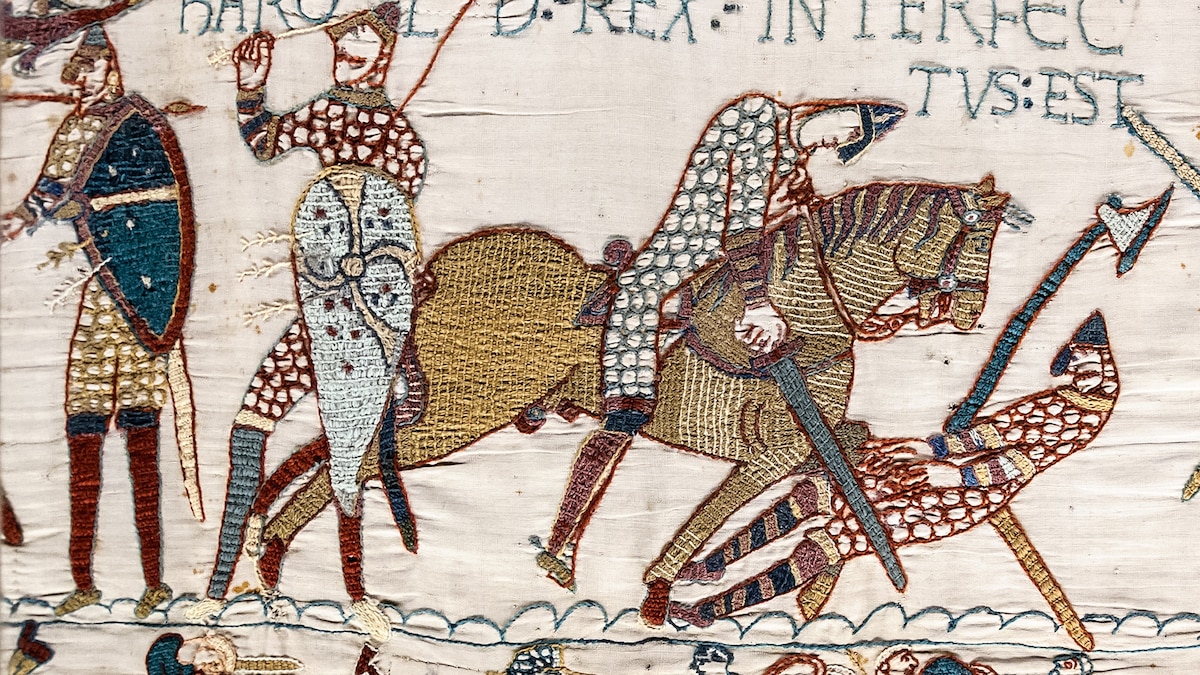
For the first time in nearly a millennium, the Bayeux Tapestry will finally be on its way back to England.
On Friday evening under heavy security, the 11th-century masterpiece that depicts William the Conqueror’s landmark 1066 victory at the Battle of Hastings, was moved into storage from its namesake museum in Bayeux, France. The tapestry will later travel to London for an exhibit at the British Museum next autumn following a rare loan from the French government.
The tapestry’s planned move from the museum in Bayeux into temporary storage was initially scheduled for September 18, but was delayed because nationwide strikes sparked concerns among local officials over the availability of security personnel to ensure the safety of the transfer of the priceless object.
For centuries, the nearly 230-foot-long linen canvas embroidered with colorful wool thread has been displayed in the Normandy town of Bayeux, first in the cathedral, and eventually at the Bayeux Tapestry Museum, which closed for renovations earlier this month.
Collaboration across the Channel
French president Emmanuel Macron announced the historic loan in July during a state visit to London, referring to the Bayeux Tapestry as “an iconic jewel of our shared history.”
(How the Bayeux Tapestry depicts the victory of William the Conqueror)
The reaction in the U.K. was jubilant, with British Prime Minister Keir Starmer calling it a “brilliant initiative” and culture secretary Lisa Nandy saying in an official statement that she was “delighted” at the prospect of welcoming “one of the most iconic pieces of art ever produced in the U.K.”
Two previous loan requests from the British government, including one in 1953 to mark the coronation of Queen Elizabeth II, were rejected, and a similar loan proposal by Macron in 2018 was scrapped after conservators deemed the time-worn relic too fragile to be moved.
“Back in 2018, we didn’t yet know enough about the physical condition of the work, which is why the loan had to be delayed,” Loïc Jamin, Bayeux’s deputy mayor in charge of culture, said in a statement. “The expertise developed and shared with the Ministry of Culture since then has been a major step toward making the loan a reality.”
Nevertheless, the upcoming cross-Channel journey has sparked renewed outrage among some French art restorers and experts, who insist that the transport of the highly delicate oeuvre could damage it beyond repair. Macron’s government, they argue, is putting diplomacy before heritage.
Following the official announcement of the loan, Didier Rykner, the editor of the online art magazine La Tribune de l’Art, launched a petition that has since garnered more than 73,500 signatures. Calling the loan a “heritage crime,” the petition argues that “any transport, however minimal, represents a danger,” and equates Macron’s decision to go forward with the loan as “mocking the experts” who oppose the move.
Even before Macron’s announcement, the French department of Calvados, which includes the town of Bayeux, released a video on its social media channels discussing the tapestry’s extreme fragility and emphasizing the “impossibility” of moving it over long distances. The video has since been removed.
(This battle lasted just one day—but forever changed England)
On the other side of the Channel, British Museum officials expressed confidence about the tapestry’s safety and handling during its transfer and subsequent exhibition.
“The British Museum has a world-leading conservation and collections management team who are experienced at handling and caring for this type of material,” a museum spokesperson said in an email, adding that the team is “working closely with colleagues in France on the tapestry’s display.”
In an editorial in The Guardian, British Museum director Nicholas Cullinan wrote that during the exhibition, the tapestry will rest on “a state-of-the-art table, designed to support its long-term preservation.” The same table, he said, will later be used when the Bayeux Tapestry Museum reopens.
Packing up a priceless artwork
In a statement, Normandy’s Regional Directorate of Cultural Affairs (DRAC) said that it conducted a detailed rehearsal back in April to ensure the tapestry’s safe removal and transfer. Without providing details, DRAC said that the work had undergone “a series of preparatory operations aimed at testing logistical procedures for the extraction of the original work and at ensuring its optimal preservation during its transfer to temporary storage.”
France 3 reported that teams from DRAC and the museum staff along with more than 100 volunteers assisted with the first phase of the move on Thursday night, which involved gently taking the tapestry down from its display and placing it behind protective glass before folding it into a crate and sealing it.
(Who hid this gold hoard in the English countryside?)
The delicate operation continued the following evening with the transport of the work in an effort that involved nearly 90 people and took more than seven hours. Bayeux’s mayor told France 3 that law enforcement escorted two trucks from the museum—one containing the 1,000-year-old treasure and the other that acted as a decoy. The tapestry was then taken to a secret storage location, according to the AFP, where it will be held before it makes its way to England.
Until now, specifics of tapestry’s removal from the museum in Bayeux had been scant, and the exact manner in which it will make its way to England remains a closely guarded secret. A spokesperson from the Bayeux Tapestry Museum declined to comment on the logistics of the operation, citing security reasons, and France’s Ministry of Culture did not respond to multiple interview requests.
Transporting the tapestry to England by plane has reportedly been ruled out partly due to a loss of climate control on the tarmac, and media reports speculate that the tapestry’s trip will involve some form of overland transport, “possibly combining road and rail with a shuttle train.”
Before Friday, the Bayeux Tapestry had been moved only twice—the first time by Napoleon, who had it displayed in Paris in an effort to drum up support for a planned invasion of England, and the second time in the 1940s during the German Occupation. At one point, the Nazis even conspired to steal the artifact in order to advance a claim that the depicted conquerors were Vikings (and hence Germanic) rather than Normans. The Third Reich did succeed in absconding with a small piece of the cloth, which remained hidden in Germany for decades after the war and is due to be returned to France.
The tapestry has had “several lucky escapes,” the Bayeux Museum notes on its website; its existence has been “marked by turbulent periods when it was in danger or at serious risk of being damaged.”
Friday’s operation marks the start of yet another eventful chapter in its 950-year history as cultural authorities on the other side of the Channel begin preparations for what British Museum chair George Osborne has called a “once in a generation” exhibition.
The Bayeux Tapestry will go on display at the British Museum’s Sainsbury Exhibitions Gallery between September 2026 and July 2027.



